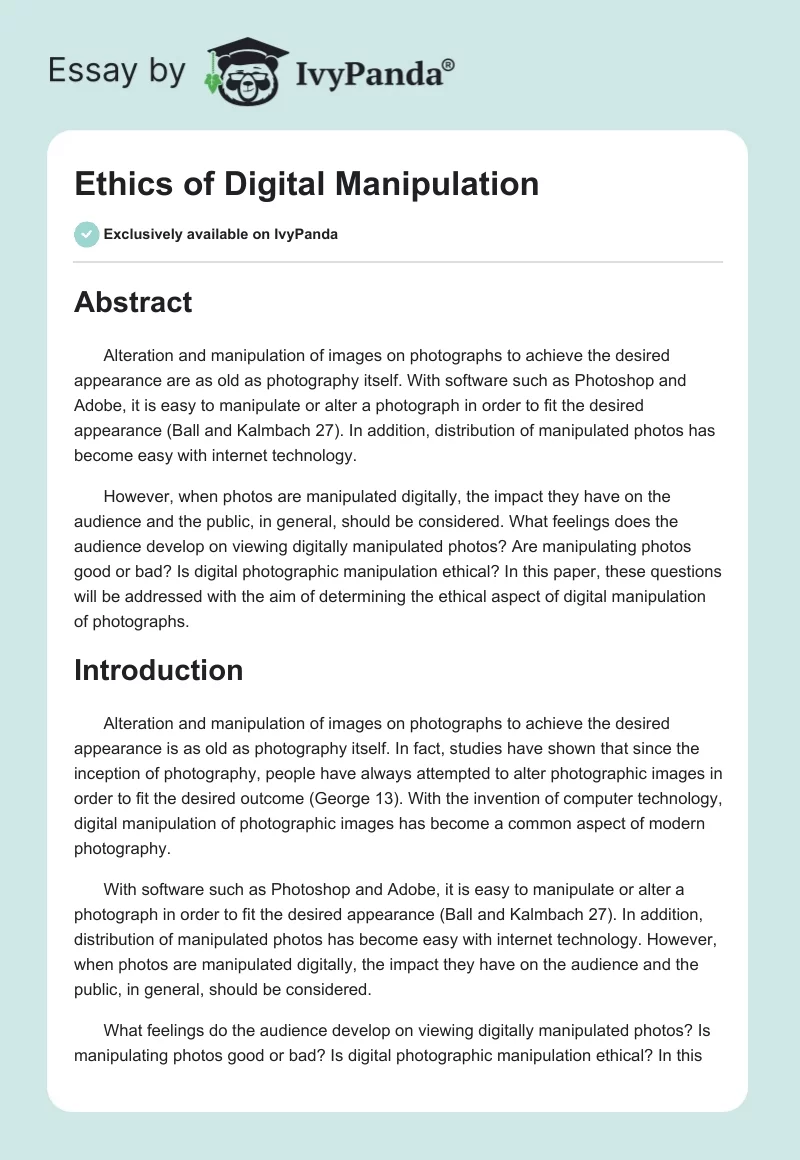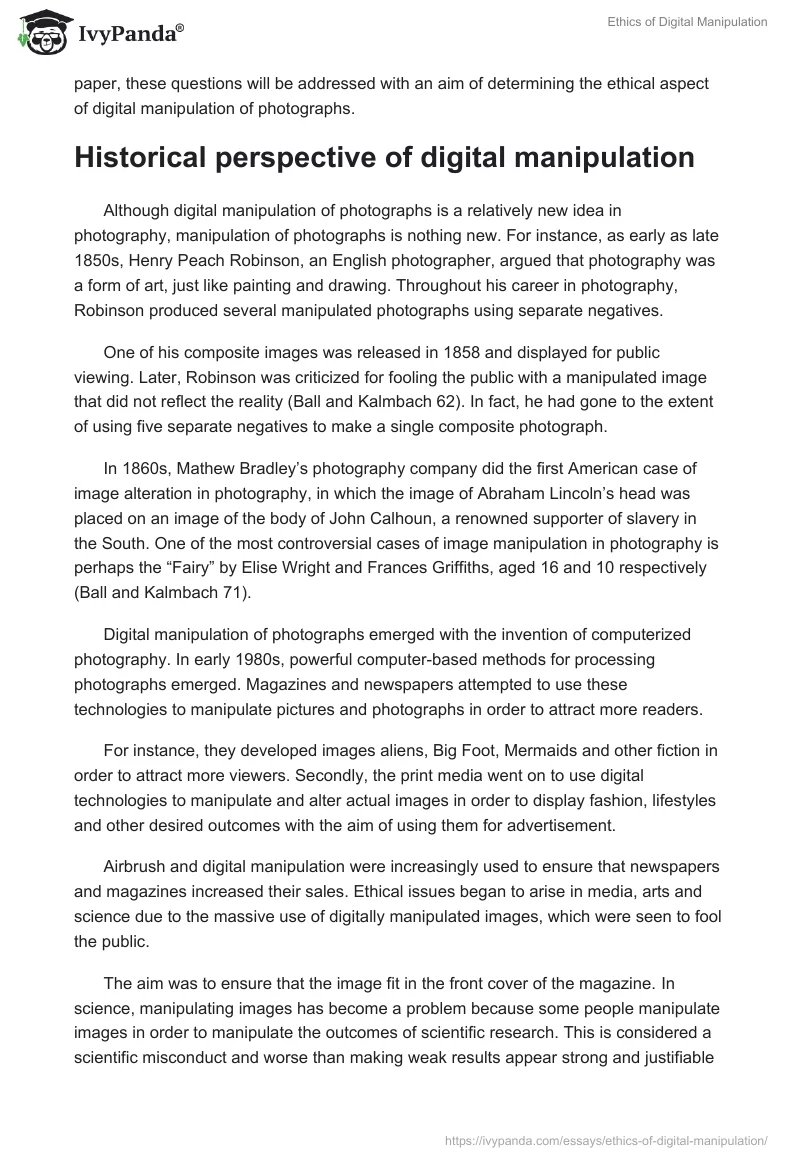Abstract
Alteration and manipulation of images on photographs to achieve the desired appearance are as old as photography itself. With software such as Photoshop and Adobe, it is easy to manipulate or alter a photograph in order to fit the desired appearance (Ball and Kalmbach 27). In addition, distribution of manipulated photos has become easy with internet technology.
However, when photos are manipulated digitally, the impact they have on the audience and the public, in general, should be considered. What feelings does the audience develop on viewing digitally manipulated photos? Are manipulating photos good or bad? Is digital photographic manipulation ethical? In this paper, these questions will be addressed with the aim of determining the ethical aspect of digital manipulation of photographs.
Introduction
Alteration and manipulation of images on photographs to achieve the desired appearance is as old as photography itself. In fact, studies have shown that since the inception of photography, people have always attempted to alter photographic images in order to fit the desired outcome (George 13). With the invention of computer technology, digital manipulation of photographic images has become a common aspect of modern photography.
With software such as Photoshop and Adobe, it is easy to manipulate or alter a photograph in order to fit the desired appearance (Ball and Kalmbach 27). In addition, distribution of manipulated photos has become easy with internet technology. However, when photos are manipulated digitally, the impact they have on the audience and the public, in general, should be considered.
What feelings do the audience develop on viewing digitally manipulated photos? Is manipulating photos good or bad? Is digital photographic manipulation ethical? In this paper, these questions will be addressed with an aim of determining the ethical aspect of digital manipulation of photographs.
Historical perspective of digital manipulation
Although digital manipulation of photographs is a relatively new idea in photography, manipulation of photographs is nothing new. For instance, as early as late 1850s, Henry Peach Robinson, an English photographer, argued that photography was a form of art, just like painting and drawing. Throughout his career in photography, Robinson produced several manipulated photographs using separate negatives.
One of his composite images was released in 1858 and displayed for public viewing. Later, Robinson was criticized for fooling the public with a manipulated image that did not reflect the reality (Ball and Kalmbach 62). In fact, he had gone to the extent of using five separate negatives to make a single composite photograph.
In 1860s, Mathew Bradley’s photography company did the first American case of image alteration in photography, in which the image of Abraham Lincoln’s head was placed on an image of the body of John Calhoun, a renowned supporter of slavery in the South. One of the most controversial cases of image manipulation in photography is perhaps the “Fairy” by Elise Wright and Frances Griffiths, aged 16 and 10 respectively (Ball and Kalmbach 71).
Digital manipulation of photographs emerged with the invention of computerized photography. In early 1980s, powerful computer-based methods for processing photographs emerged. Magazines and newspapers attempted to use these technologies to manipulate pictures and photographs in order to attract more readers.
For instance, they developed images aliens, Big Foot, Mermaids and other fiction in order to attract more viewers. Secondly, the print media went on to use digital technologies to manipulate and alter actual images in order to display fashion, lifestyles and other desired outcomes with the aim of using them for advertisement.
Airbrush and digital manipulation were increasingly used to ensure that newspapers and magazines increased their sales. Ethical issues began to arise in media, arts and science due to the massive use of digitally manipulated images, which were seen to fool the public.
The aim was to ensure that the image fit in the front cover of the magazine. In science, manipulating images has become a problem because some people manipulate images in order to manipulate the outcomes of scientific research. This is considered a scientific misconduct and worse than making weak results appear strong and justifiable for publication. In fact, most scientific institutions have restricted the use of digitally manipulated photographs.
Is digital manipulation of photo images ethical?
Digital manipulation of photographs has been criticized for its capacity to mislead or fool the public. One of the major areas that have become highly controversial as far as the use of digital manipulation of photographs is the public health. Violation of social standards and professional codes of ethics have become common issues associated with digital manipulation (Carlson and Oliva 19).
For instance, magazines, newspapers, Telemedia, online pages and periodicals have been used for advertising household products, including food, drinks, cosmetics, medicine, clothing and make-ups. Often, photographic images are used to reach out to the public and attract more buyers. However, in most cases, images are digitally manipulated in order to appeal the public.
This phenomenon has been criticized for misleading the consumers, which has also been shown to have an impact on public health (Carlson and Oliva 18). For instance, medical evidence has shown that cosmetic and pharmaceutical companies tend to use digital manipulation to produce altered images that exaggerate the evidence intended for the audience.
For instance, cosmetic manufacturers have always used images of beauties and models to show how the intended consumer will achieve new beauty when he or she uses the product. However, most of the images are merely exaggerations with digital manipulation. In addition, food processors use similar methods to mislead the public that once a certain product is consumed, the consumer will achieve an ideal body status as indicated by the advertised image.
In medical health, the national center for biotechnology information has shown that more than 50% of American girls and women are unhappy with their bodies because they cannot achieve the beauty and shape advertised by food and cosmetic manufacturers.
The institution has argued that exposure to thin-media images has the potential to contribute to poor eating habits and disorders because the audience realizes that they can achieve the similar looks to those advertised with the images (Hawkins, Richards, Granley and Stein 36). In addition, young women and girls are likely to develop dissatisfaction and low self-esteem.
According to the Centres for Disease Control and Prevention (CDC 2009), unhealthy eating and weight loss are a public health problem, especially among the young women and girls. The study indicates that 14% of high school girls may be attempted to miss their meals for at least 24 hours in an effort to lose weight.
About 5% of the girls revealed that they had attempted to use laxatives or stimulated vomiting to avoid gaining bodyweight (Stice and Shaw 383). The majority of the girls reported that they wanted to “look like” a certain model advertised in the media. In this case, it is evident that digital manipulation of photographs has affected the public health.
According to a study by the American medical association (2011), photo alteration and manipulation often lead to unrealistic ideals about the human body by creating unrealistic images of people with ideal bodies. The study encourages the public to work with the private sector and authorities in ensuring that alteration of photographs is not used in an advertisement.
This is important in cases where such images presented have the potential to promote unrealistic ideas and expectations of the body image. Secondly, concerns have also been raised due to the use of excessive exaggeration of images advertised by tourism and hospitality institutions. For example, photographic sceneries of hotels, wildlife and natural landscape are sometimes digitally manipulated in order to attract more viewers and visitors.
In actual sense, this is equal to false advertisement, which is illegal in most jurisdictions. In addition, it is unethical for individuals and institutions to alter images in order to fool their audience. Manipulating physical attributes of individuals has an effect of causing emotional harm to that person.
For instance, when a person’s image is altered to give it a new look without his or her consent, it is likely that the person will feel embarrassed (Burns and Cleary-Burns 43). In addition, people tend to feel embarrassed if their objects are altered with digital photography if they are given unattractive looks.
Conclusion
Although manipulation of images is not a new phenomenon, using digital technologies to alter photographs has increasingly become an ethical issue because computer technologies have allowed people to have a free access to and use of computer-based technologies. Any person can manipulate images of other people, objects or sceneries with or without seeking for consent.
In the medical field, advertising products with digitally altered images causes poor health and eating disorders, low-self esteem and negative moods among the young people. In addition, it has been shown that scientific field is experiencing problems with researchers who use digital manipulation of photos to manipulate results. Digital photographic manipulation has the potential to cause emotional harm to the people whose images are manipulated without their consent.
Despite this, digital manipulation remains an important part of photography and allows the media and individuals to create the desired images. In this way, it creates employment opportunities, thus improving the economy (George 16). Therefore, without the appropriate laws and regulations to reduce the negative impacts of digital manipulation of photographs, the technique will remain unethical.
Works Cited
Ball, Cheryl and James Kalmbach. RAW: Reading and writing new media. Cresskill, NJ: Hampton Press, 2010. Print
Burns, Stanley and Sara Cleary-Burns. News art: Manipulated photographs from the Burns Archive. Brooklyn, NY: PowerHouse Books, 2009. Print.
Carlson, Kathryn, Brian DeLevie, and Aude Oliva. “Ethics in image manipulation”. ACM SIGGRAPH, 3.2 (2010): 12-27. Print.
George, Diana. “From analysis to design: Visual communication in the teaching of writing”. College Composition and Communication, 54.2 (2002): 11-39. Print
Hawkins N, Richards PS, Granley HM and Stein DM. “The impact of exposure to the thin-ideal media image on women”. Eat Disord, 12.1 (2004): 35-50. Print
Stice, Elvin and Elis Shaw. “Adverse effects of the media portrayed thin-ideal on women and linkages to bulimic symptomatology”. Journal of Social and Clinical Psychology, 13.2 (2004): 288-308. Print


